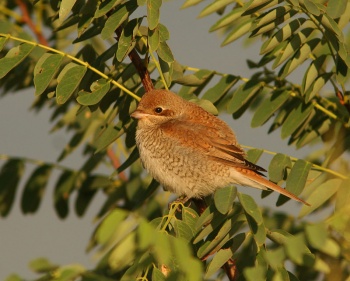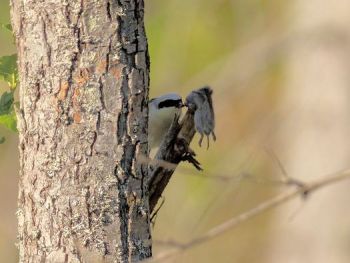- Lanius collurio
Identification
Length 17 cm, weight 23-34 g
Rufous-brown above and creamy to pink below. Looks 'long' in flight.
Male
Blue-grey head and rump, with a bold black eye-stripe. Black tail with white sides (superficially reminiscent of Northern Wheatear)
Female
Browner; head grey-brown with a dark cheek patch. 'Scaly' with crescent-shaped feather fringes on underparts
Juvenile
Brown above with dark bars. 'Scaly' with crescent-shaped feather fringes covering the body.
Distribution
Red-backed Shrike was formerly a fairly common summer visitor to the UK, but is now only a sporadic breeder. It can still be seen on passage, mainly on the east coast. It still breeds - though often at low density - in most of mainland Europe and northwest Asia (east to western Siberia) between roughly 40° to 65°N latitude. According to The Birds of the Western Palearctic - Concise Edition there were an estimated 200,000 - 210,000 pairs in Ukraine in 1986, and the population is fairly stable. It also breeds in southwest Asia from Turkey to northwest Iran. Further east, it is replaced by Brown Shrike, and southeast, by Isabelline Shrike; some hybridisation with both occurs where their ranges meet.
The birds winter in tropical and southern Africa.
Taxonomy
This is a monotypic species[1].
Habitat
Heathland, overgrown hedges and ditches, and low-intensity farmland.
Behaviour
Breeding
Nests in trees, bushes or bramble thickets.
Diet
The diet includes large insects, small birds, voles and lizards.
As with most other shrike species, it impales its prey on spikes.
Vocalisation
References
- Clements, J. F., T. S. Schulenberg, M. J. Iliff, S. M. Billerman, T. A. Fredericks, B. L. Sullivan, and C. L. Wood. 2019. The eBird/Clements Checklist of Birds of the World: v2019. Downloaded from http://www.birds.cornell.edu/clementschecklist/download/
- Birdwatchers Pocket Guide ISBN 1-85732-804-3
- Collins Pocket Guide to British Birds 1966
- Collins Field Guide 5th Edition
Recommended Citation
- BirdForum Opus contributors. (2024) Red-backed Shrike. In: BirdForum, the forum for wild birds and birding. Retrieved 23 April 2024 from https://www.birdforum.net/opus/Red-backed_Shrike
External Links
Search the Gallery using the scientific name:
GSearch checked for 2020 platform.








